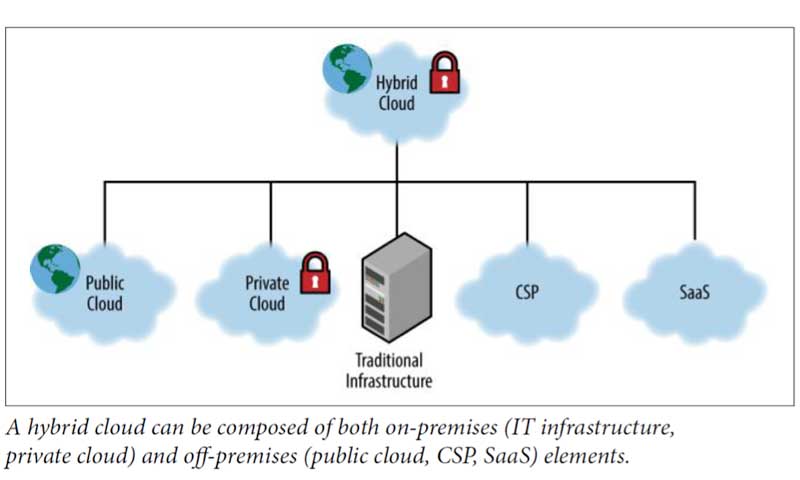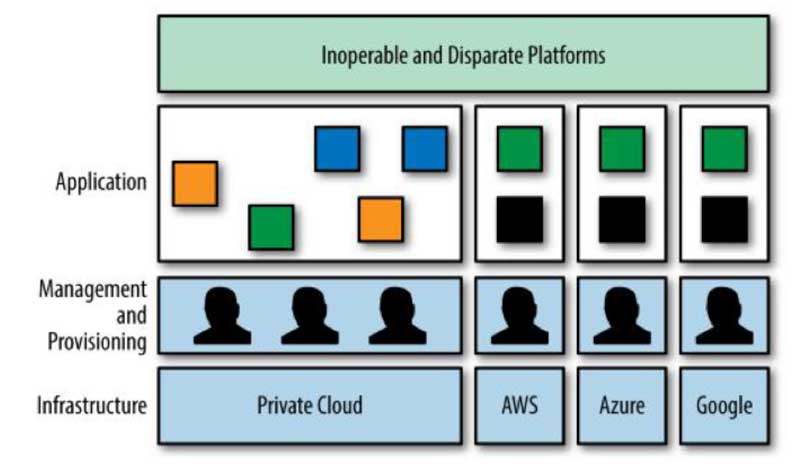Technology may not get lead credits in the story of a successful business, but it is undoubtedly the unsung hero that holds all the pieces of the puzzle together. Often behind the scenes, IT departments enable groundbreaking ideas, more efficient processes and infrastructure that empowers businesses to reach their potential in the Information Age.
Cloud computing is one of the biggest IT disruptors over the last decade. It has grown and branched into private, public and multicloud, forcing organizations to evolve their in-house to a hybrid IT approach in order to get the best of all worlds.

Source: Designing and Building a Hybrid Cloud
Data from IDC gives us a perspective on how pervasive the cloud has become in enterprise IT. A staggering 83% of workloads are virtualized or run on the cloud today, with 65% of organizations reposing their faith in a hybrid cloud strategy. This scale of cloud adoption overall and hybrid cloud adoption in particular, is a clear sign for businesses to start thinking whether hybrid cloud systems deployed within an efficient hyperconverged infrastructure (HCI) is necessary for a competitive advantage.
Hybrid IT is a proven infrastructure path that doesn’t just manage disparate cloud environments, but also builds on their benefits to open up exponential growth opportunities to organizations.
A Single Operating System for Many Clouds
Any organization that uses more than one cloud in their technology stack, has lived the reality of juggling multiple cloud service providers and their unique problems. As with individual software platforms, each cloud service has its own distinctive quirks and capabilities. Some offer a high degree of personalization, some offer stronger security, while others are great at ensuring availability round the clock.
While it’s usually great to have variety and options, when it comes to a smooth and efficient IT infrastructure, differences make managing data and apps across cloud networks difficult and unpredictable. Herein lies the appeal of a single platform that brings together all legacy systems in use under one umbrella.

Source: Designing and Building a Hybrid Cloud
Services like Nutanix Enterprise Cloud allow businesses to rely on a “single pane of glass” for managing workloads, monitoring performance and maintaining security and governance protocols seamlessly, so that the IT team doesn’t have to wrestle with multiple “tool suites” only to use one or two features from each of them.
Business Goals Dictate How the Hybrid Cloud is Set Up
Moving an organization’s IT infrastructure into a hybrid cloud approach isn’t a matter that just concerns the IT team. It has impact across teams and business units. Short and long term goals, constraints, security and governance protocols, and day-to-day operations are all key factors to consider.
A clear view of business objectives helps in optimal asset utilization and architecting the hybrid cloud to respond to business needs swiftly and efficiently. For instance, if quick, seasonal scalability is an organizational priority, then the type of hybrid cloud required will be very different from the one that will be set up if continuous availability is the primary concern.
Once organizational priorities are spelt out, a clear set of measurement metrics for the transition is critical for marking progress. A scalable cloud approach needs to measure time required to expand capacity to meet expected and unexpected needs.

When Ports of America struggled to manage its myriad of IT systems, they turned to the Nutanix Enterprise Cloud OS, which allowed Ports of America to consolidate control of their patchwork of technologies. This accelerated their digital transformation, according to Peter Curren, Global Infrastructure Director.
“The solution has enabled us to really take a lot of our workloads from critical business systems, both locally at terminal and in centralized locations, and respond in a much more agile way to business requirements,” said Curren.
[Read related case study: Leading U.S. Terminal Operator Improves Agility and Dependability by Consolidating Siloed Systems]
By modernizing their data centers, the Ports of America were able to minimize interruptions to operations, improve insight and control, and free IT to focus on creating business value.
Compatible Tech is Productive Tech
The priorities that govern which cloud service a team picks for particular workloads, may be very different from priorities of other teams across the organization. While it’s justifiable for different teams to leverage different technologies or services to accomplish their goals, it’s necessary from an IT management perspective to make sure these technologies play nice with each other.
“Across infrastructure, compatibility can prove itself to be a major issue when building a hybrid cloud,” said Aaron Lumnah of Actifio.
“With dual levels of infrastructure, a private cloud that the company controls, and a public one that the company leverages, the chances are that they will be running different stacks. Can you manage both using the same tools, or will your team have to learn a new set in order to effectively oversee them?”

Source: Nutanix Hybrid Cloud VDI
When cloud services for different applications are interchangeable, it saves the company critical time, money and resources by avoiding a complete re-engineering effort. Consistent architectures that work well together allow developers to create apps or software that run equally robustly whether on the public or private cloud.
A Place for Everything and Everything in its Place
One of the core benefits of Hybrid IT is the power to combine public and private clouds offering completely different features into a single unified cloud ecosystem. However, just because hybrid IT uses both public and private clouds simultaneously, it does not mean workloads can be assigned to whichever cloud at random.
A workload should live on a particular cloud only if the cloud meets the requirements of executing such a workload. For instance, an app that handles highly secure customer data may be best suited to run on a private cloud or a local server in order to minimize security risks.
Hybrid IT ecosystems that are managed via a dedicated cloud operating system allow portability of apps and data across different cloud networks smoothly. This means that once workloads are allocated to particular clouds in a hybrid IT environment, users have the option of moving apps and data around within the network while ensuring that any such move prioritizes individual app requirements before any transitions.
Change is Hard, Be Ready
Newton’s first law of motion captures the state of technology and its users inside businesses succinctly. In the absence of an external, unbalanced force, these tend to coast along and continue down their preset paths without any problems. A digital transformation effort or a migration to a hybrid IT platform can be a major disruptive force in all these trajectories, throwing both people and processes out of whack.
Prepare people, set up automation systems and workflows, and modify organizational policies adequately early in any migration or transformation process. Educate staff about the move and the benefits it will bring. This will reduce the inevitable resistance to change and smooth the way ahead for the actual transition.
The winning mantra for a successful transition to hybrid IT? Prepare, prepare and prepare some more!
Featured Image by Pixabay
Dipti Parmar is a contributing writer. She has written for CIO.com, Entrepreneur, CMO.com and Inc. magazine. Follow her on Twitter @dipTparmar.
© 2020 Nutanix, Inc. All rights reserved. For additional legal information, please go here.


